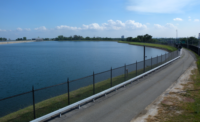...the activated sludge system design allowed for the team to use existing infrastructure on the site, rather than building an entirely new facility and supporting infrastructure. That change alone has saved Indianapolis approximately $90 million, according to DLZ’s Jacob.
Walsh Construction is the contractor on the $53.6-million project. Construction began in spring 2010. Bolden says the work is about 40% done “and on time and on budget,” with completion expected in summer 2012.
Green Experiment
The DPW also worked on a “green for gray” approach to easing how much water actually gets to the treatment plants. Officials hope to replicate the green stormwater infrastructure project at up to 60 additional sites around the city.
The Fall Creek pilot project, built in 2009, involved partially separating combined sewers and then redirecting stormwater via a new storm sewer pipe to a 70-ft by 35-ft bioretention cell for treatment.
The setup is simple: A stone filter at the base of the cell temporarily holds stormwater at bay until it rises to the top of the filter. Once it reaches the top, the water flows onto the surface and is absorbed into the cell. After the water filters through the system of native plants, soil and stone in the bioretention cell, it is released into a local creek (see infographic above).

BALLARD
The city is now in the process of monitoring water flows and capturing data, which it plans to share with the Environmental Protection Agency and U.S. cities as a way to build sustainability into compliance with consent decrees.
Although the green project was not part of the consent decree, it can impact consent decree projects, DPW says, because it contributes to cleaner water ultimately entering the wastewater treatment facilities. Green solutions like the Fall Creek pilot project “are not the panacea to solve all CSO overflow problems, but they can help,” DLZ’s Jacob says.
Negotiating Change
City staff and the program management team worked continuously with designers to reassess and develop economical, yet environmentally friendly solutions to the CSO plans, such as the Fall Creek project. “We have found some pretty decent solutions this way,” Sherman says. “Basically, [the EPA] saw that we could show them through modeling [and adding green approaches] that the effluent could be better, faster—that we had actually added volume through re-engineering, and we had capacity in the collections system and the programs.”
Better, more sophisticated modeling showed that overflow volume was lower than originally thought, says Jacob. Moreover, adding volume through the Deep Rock Tunnel meant that, in other parts of the system, smaller pipes could be used that would be easier to dig with standard tunnel-boring equipment. An amendment to the consent decree “set the stages for 14 changes that allowed us to downsize some of the upstream tunnels and downsize some of the treatment plant projects, because the Deep Rock Tunnel now would store a lot of the surge until after a storm passed,” Jacob says.
City officials say the changes in the enhancement plan should allow Indianapolis to reduce the amount of total annual discharge to about 414 million gallons—a significant improvement from the 642 million gallons expected under the original consent decree—and reduce the project’s cost by about $444 million.
Ballard presented the modified plan and its anticipated costs at the U.S. Conference of Mayors Water Summit in December. “We are moving forward with unprecedented progress that others are seeking to emulate,” he said at the time.
Sherman sees the experience as “probably a pretty good model for how it can be done.” One factor made the difference. “I think the biggest thing—the reason we saved the money and we’re getting more sewage up early—we took a holistic approach to the entire collection system.”
BENEFITS OF DEEP ROCK TUNNEL CONNECTOR
•Capture and treat an additionalone billion gallons of raw sewage through 2021 when compared to the original designImprove management of flows between city’s two treatment plantsEliminate one of two previously planned pumping stations fora savings of approximately$30 millionLimit problems with utilities and groundwater because of thedepth of the tunnel
•Improve management of flows between city�s two treatment plants
•Eliminate one of two previously planned pumping stations for a savings of approximately $30 million
•Limit problems with utilities and groundwater because of the depth of the tunnel








